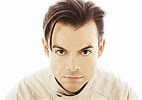'A Christmas Carol' at IRT displays imaginative elan, underlines its moral lesson

The rude thump of a heavy walking stick interrupts a flash-mob-like rendition of a Christmas carol to start off Indiana Repertory Theatre 's production of "A Christmas Carol." On opening night Saturday, it had the intended startling effect — a real one for the audience and me, a well-rehearsed one for the carolers divided by the frosty approach of Ebenezer Scrooge. He strides without speaking through the stunned singers on the way to his office. Bah! Humbug!: Scrooge casts a disdainful eye at Christmas. The arresting opening scene places the mean-spirited miser in a social context, where we will not see him again in his real self until his conversion near the end, after guided visions by the Ghosts of Christmas Past, Present, and Yet to Come. Scrooge famously learns from those visits — a posthumous gift thrust upon him by a miserable ghost, his deceased business partner — the personal benefits of charity. Among our traditional carols, the interrupted "Good














